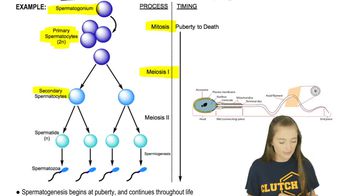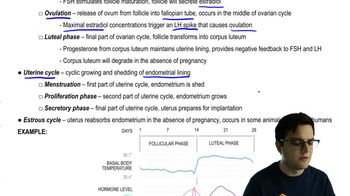Table of contents
- 1. Introduction to Biology2h 40m
- 2. Chemistry3h 40m
- 3. Water1h 26m
- 4. Biomolecules2h 23m
- 5. Cell Components2h 26m
- 6. The Membrane2h 31m
- 7. Energy and Metabolism2h 0m
- 8. Respiration2h 40m
- 9. Photosynthesis2h 49m
- 10. Cell Signaling59m
- 11. Cell Division2h 47m
- 12. Meiosis2h 0m
- 13. Mendelian Genetics4h 41m
- Introduction to Mendel's Experiments7m
- Genotype vs. Phenotype17m
- Punnett Squares13m
- Mendel's Experiments26m
- Mendel's Laws18m
- Monohybrid Crosses16m
- Test Crosses14m
- Dihybrid Crosses20m
- Punnett Square Probability26m
- Incomplete Dominance vs. Codominance20m
- Epistasis7m
- Non-Mendelian Genetics12m
- Pedigrees6m
- Autosomal Inheritance21m
- Sex-Linked Inheritance43m
- X-Inactivation9m
- 14. DNA Synthesis2h 27m
- 15. Gene Expression3h 20m
- 16. Regulation of Expression3h 31m
- Introduction to Regulation of Gene Expression13m
- Prokaryotic Gene Regulation via Operons27m
- The Lac Operon21m
- Glucose's Impact on Lac Operon25m
- The Trp Operon20m
- Review of the Lac Operon & Trp Operon11m
- Introduction to Eukaryotic Gene Regulation9m
- Eukaryotic Chromatin Modifications16m
- Eukaryotic Transcriptional Control22m
- Eukaryotic Post-Transcriptional Regulation28m
- Eukaryotic Post-Translational Regulation13m
- 17. Viruses37m
- 18. Biotechnology2h 58m
- 19. Genomics17m
- 20. Development1h 5m
- 21. Evolution3h 1m
- 22. Evolution of Populations3h 52m
- 23. Speciation1h 37m
- 24. History of Life on Earth2h 6m
- 25. Phylogeny2h 31m
- 26. Prokaryotes4h 59m
- 27. Protists1h 12m
- 28. Plants1h 22m
- 29. Fungi36m
- 30. Overview of Animals34m
- 31. Invertebrates1h 2m
- 32. Vertebrates50m
- 33. Plant Anatomy1h 3m
- 34. Vascular Plant Transport2m
- 35. Soil37m
- 36. Plant Reproduction47m
- 37. Plant Sensation and Response1h 9m
- 38. Animal Form and Function1h 19m
- 39. Digestive System10m
- 40. Circulatory System1h 57m
- 41. Immune System1h 12m
- 42. Osmoregulation and Excretion50m
- 43. Endocrine System4m
- 44. Animal Reproduction2m
- 45. Nervous System55m
- 46. Sensory Systems46m
- 47. Muscle Systems23m
- 48. Ecology3h 11m
- Introduction to Ecology20m
- Biogeography14m
- Earth's Climate Patterns50m
- Introduction to Terrestrial Biomes10m
- Terrestrial Biomes: Near Equator13m
- Terrestrial Biomes: Temperate Regions10m
- Terrestrial Biomes: Northern Regions15m
- Introduction to Aquatic Biomes27m
- Freshwater Aquatic Biomes14m
- Marine Aquatic Biomes13m
- 49. Animal Behavior28m
- 50. Population Ecology3h 41m
- Introduction to Population Ecology28m
- Population Sampling Methods23m
- Life History12m
- Population Demography17m
- Factors Limiting Population Growth14m
- Introduction to Population Growth Models22m
- Linear Population Growth6m
- Exponential Population Growth29m
- Logistic Population Growth32m
- r/K Selection10m
- The Human Population22m
- 51. Community Ecology2h 46m
- Introduction to Community Ecology2m
- Introduction to Community Interactions9m
- Community Interactions: Competition (-/-)38m
- Community Interactions: Exploitation (+/-)23m
- Community Interactions: Mutualism (+/+) & Commensalism (+/0)9m
- Community Structure35m
- Community Dynamics26m
- Geographic Impact on Communities21m
- 52. Ecosystems2h 36m
- 53. Conservation Biology24m
44. Animal Reproduction
Animal Reproduction
Problem 4a
Textbook Question
A sperm cell follows which path? a. seminiferous tubules, epididymis, vas deferens, urethra; b. urethra, vas deferens, seminiferous tubules, epididymis; c. seminiferous tubules, vas deferens, epididymis, urethra; d. epididymis, seminiferous tubules, vas deferens, urethra; e. epididymis, vas deferens, seminiferous tubules, urethra
 Verified step by step guidance
Verified step by step guidance1
Identify the starting point of sperm production in the male reproductive system, which is the seminiferous tubules located within the testes.
Determine the next location where sperm mature and are stored after being produced in the seminiferous tubules. This location is the epididymis.
Trace the path that mature sperm take as they leave the epididymis during ejaculation. The next structure they travel through is the vas deferens.
Follow the path from the vas deferens to where the sperm are mixed with seminal fluid to form semen. This occurs as the vas deferens connects to the ejaculatory ducts and then to the urethra.
Conclude the pathway by identifying the final exit point of the semen, which includes sperm, from the male body, which is the urethra.
Recommended similar problem, with video answer:
 Verified Solution
Verified SolutionThis video solution was recommended by our tutors as helpful for the problem above
Video duration:
1mPlay a video:
Was this helpful?
Key Concepts
Here are the essential concepts you must grasp in order to answer the question correctly.
Spermatogenesis
Spermatogenesis is the process by which sperm cells are produced in the seminiferous tubules of the testes. This complex process involves the division and maturation of germ cells, ultimately leading to the formation of mature spermatozoa. Understanding this process is crucial for tracing the path of sperm cells as they develop and move through the male reproductive system.
Recommended video:
Guided course

Spermatogenesis
Male Reproductive Anatomy
The male reproductive system includes several key structures: the seminiferous tubules, epididymis, vas deferens, and urethra. Sperm cells are produced in the seminiferous tubules, then stored and matured in the epididymis. The vas deferens transports sperm from the epididymis to the urethra, which serves as the final passage for sperm to exit the body during ejaculation.
Recommended video:
Guided course

Male Reproductive Anatomy
Pathway of Sperm Transport
The pathway of sperm transport is a sequential route that sperm cells follow from their site of production to their exit from the body. This pathway begins in the seminiferous tubules, continues to the epididymis for maturation, then moves through the vas deferens, and finally exits via the urethra. Understanding this pathway is essential for answering questions about sperm cell movement and reproductive physiology.
Recommended video:
Guided course

Active Transport

 5:44m
5:44mWatch next
Master Sexual and Asexual Reproduction with a bite sized video explanation from Jason Amores Sumpter
Start learningRelated Videos
Related Practice

































































